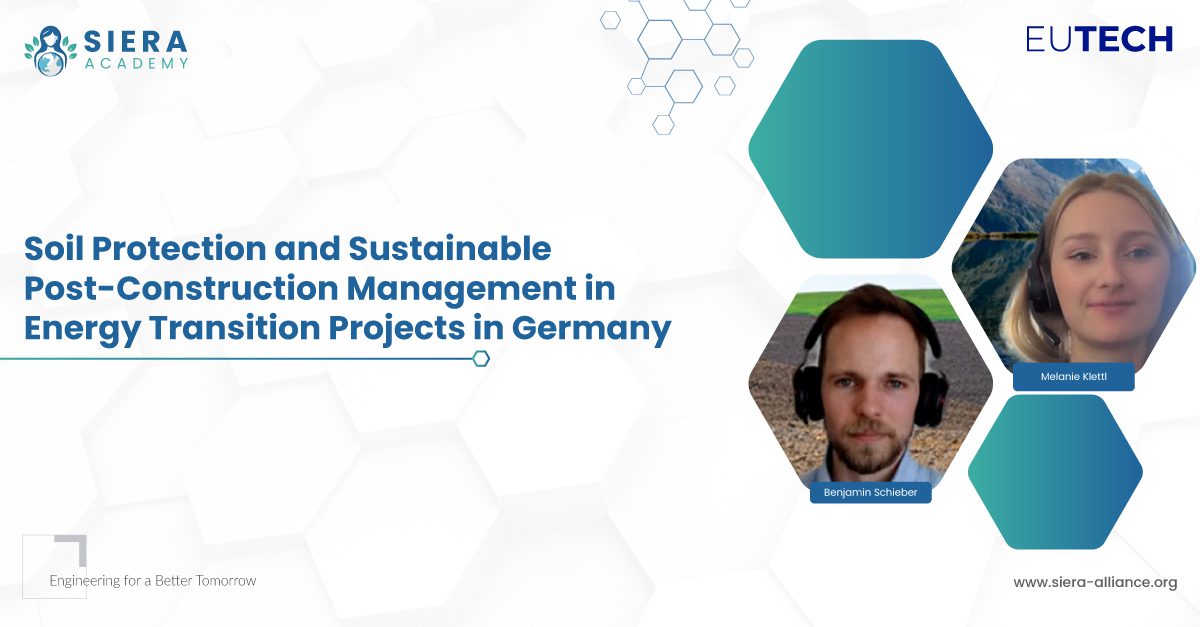Sustainable Practices for Long-Term Soil Health in the Energy Transition
Energy transition projects in Germany, from wind farms to solar parks and transmission grids, play a pivotal role in reducing the nation’s carbon footprint. However, these projects bring significant challenges, particularly concerning soil protection during construction and post-construction phases. On April 9, 2025, the SIERA Academy Impact Series webinar, titled “Soil Protection and Sustainable Post-Construction Management in Energy Transition Projects in Germany,” explored the critical need for soil conservation, the regulatory landscape, and practical solutions to protect soil and enhance biodiversity during these infrastructure expansions.
This blog delves deep into the insights shared during the webinar, highlighting the risks, the regulatory framework, and the strategic opportunities that businesses can leverage to ensure sustainable energy transition projects while protecting valuable soil resources.
The Challenges: Why Soil Protection is Key to the Energy Transition
The rapid expansion of energy infrastructure is essential to meet renewable energy goals, but it also puts considerable strain on the land. With over 70,000 km of new transmission lines planned in Germany, soil health and functionality are at risk. This strain on soil is caused by:
- Compaction: Heavy construction equipment leads to soil compaction, diminishing its ability to store water and nutrients and negatively affecting plant growth.
- Erosion: The removal of vegetation during construction exposes soil to erosion from wind and water, reducing its fertility and causing long-term damage.
- Sealing: The creation of impervious surfaces, like roads and construction pads, limits soil’s ability to absorb water and contribute to groundwater recharge.
Benjamin Schieber, a key speaker at the webinar, emphasized that these issues not only affect soil health but also disrupt ecosystems and agricultural productivity, making it crucial to address soil protection as a primary concern in all energy transition projects.
Regulatory Landscape: Ensuring Compliance with EU Standards
The European Union has laid out a regulatory framework that aims to balance infrastructure development with environmental protection. The CSRD (Corporate Sustainability Reporting Directive) and ESRS (European Sustainability Reporting Standards) are the key instruments for businesses to assess and report on environmental impacts, including those related to soil protection. Companies must disclose:
| ESRS Standard | Relevance to Soil Protection |
| E1: Climate Change | Impact of soil degradation on carbon sequestration and ecosystem resilience |
| E2: Pollution | Pollution caused by soil contamination from construction activities |
| E3: Water & Marine | Runoff from construction sites affecting water quality |
| E4: Biodiversity | Impact of soil degradation on habitats and biodiversity |
| E5: Resource Use | Sustainable land use practices to prevent soil degradation |
Key Regulatory Directives:
- Water Framework Directive (WFD): Regulates the protection of water bodies from pollution, including soil runoff.
- Environmental Liability Directive (ELD): Holds companies accountable for any soil contamination they cause and requires remediation efforts.
- Waste Framework Directive (WFD): Governs soil disposal, ensuring hazardous materials are managed responsibly.
Through these regulations, businesses are not only required to protect soil during construction but must also ensure long-term sustainability by integrating soil protection strategies into their overall project planning and operations.
The Opportunity: Soil Protection as a Business Advantage
Soil protection is no longer just a compliance issue—it is an opportunity for businesses to enhance operational resilience, meet regulatory requirements, and improve environmental performance. The webinar highlighted several business advantages of implementing proactive soil protection strategies:
| Opportunity Area | Key Benefits |
| Operational Continuity | Prevents costly project delays and reduces the risk of damage to infrastructure |
| Financial Resilience | Mitigates fines, insurance costs, and regulatory penalties |
| Reputation & Stakeholder Trust | Enhances corporate image by demonstrating environmental responsibility |
| Biodiversity & Ecosystem Health | Restores ecosystem functionality and promotes sustainability |
By addressing soil protection from the outset, project developers can avoid costly remediation efforts later, reduce operational risks, and improve their overall sustainability profile.
The Solutions: Integrating Sustainable Practices into Energy Transition Projects
1. Engineered Solutions
Traditional engineering solutions, such as floodwalls and stormwater retention systems, remain essential for mitigating immediate soil degradation risks. However, a more comprehensive approach integrates these with sustainable construction practices.
- Minimizing Compaction: Using lightweight machinery, optimizing traffic routes, and installing protective mats reduce soil compaction during construction.
- Erosion Control: Erosion barriers, silt fences, and strategic landscaping help prevent soil erosion and protect soil integrity.
- Low-Impact Construction: Using permeable materials, designing for minimal land disturbance, and controlling excavation processes are key to limiting soil impact.
2. Nature-Based Solutions (NbS)
Incorporating nature-based solutions is an effective way to protect and restore soil. These solutions align with the EU’s EU Taxonomy for sustainable activities, helping companies mitigate environmental impact while complying with regulations.
- Agrivoltaics: A promising solution where solar panels are installed above agricultural land, allowing crops to continue growing underneath. This dual land-use system supports both renewable energy generation and soil protection by reducing evaporation and protecting crops from extreme weather.
- Wetland Restoration: Restoring wetlands around energy projects helps absorb floodwaters, improve water quality, and enhance biodiversity.
- Reforestation and Afforestation: Planting trees can prevent erosion, improve soil structure, and contribute to carbon sequestration.
3. Carbon Sequestration and Soil Health
Carbon sequestration plays a crucial role in energy transition projects by capturing CO₂ in soil. Healthy soils act as carbon sinks, locking away atmospheric carbon and contributing to climate change mitigation. By implementing sustainable land management practices, energy projects can enhance soil health, reduce carbon emissions, and promote long-term ecosystem resilience.
Case Study: The Transmission Grid Expansion in Germany
A key case study discussed in the webinar was the Germany Transmission Grid Expansion Project. The expansion involves the construction of over 70,000 km of new transmission lines to transport renewable energy from the northern part of Germany to the central and southern regions.
The Challenge:
The project requires large-scale underground cable installations, which place significant pressure on soil health. The construction spans over 100 km of agricultural land, affecting soil structure, causing compaction, and increasing the risk of erosion.
The Solution:
To address these risks, TABERG Ingenieure GmbH (M&P Group) implemented a Bodenkundliche Baubegleitung (BBB) to monitor and mitigate soil degradation. This included:
- Soil-Sensitive Routing: Using GIS and soil resistance mapping to identify high-risk areas and plan the construction route accordingly.
- Topsoil Stripping: Removing and separately storing topsoil during excavation to preserve soil structure.
- Restoration: After construction, the land was restored using deep tillage and native seeding to promote biodiversity and restore soil functionality.
Outcome:
The project achieved long-term soil protection, minimized environmental impact, and ensured compliance with EU regulations. By implementing these proactive measures, the transmission project avoided significant soil degradation and contributed to sustainable land management.
The Role of SIERA in Supporting Soil Protection
SIERA Advisors support energy transition projects by offering tailored solutions to meet regulatory requirements and enhance soil protection. Our services include:
- Soil Contamination Assessment: Identifying and mitigating soil pollution risks before construction begins.
- Carbon Sequestration Strategies: Implementing best practices for enhancing soil health and capturing carbon.
- Compliance with CSRD and ESRS: Helping companies meet reporting standards and integrate sustainability practices into project planning.
- SustainSuite: Our digital tool for real-time monitoring of environmental impacts, ensuring projects align with regulatory standards. Book a free demo now.
Upcoming Events and Opportunities
Stay updated on future events. For more insights and information on our upcoming SIERA Impact Series Webinars, explore the Event Calendar. Lear more and register for our free to join digital events.
Take the Next Step with SIERA
Soil protection isn’t just an environmental obligation—it’s an opportunity to build sustainable, resilient infrastructure that benefits both business and the planet. At SIERA Alliance, we work with developers, municipalities, and stakeholders to create effective soil management strategies for energy transition projects.
Get in touch with SIERA Advisors to learn how we can help you implement sustainable soil protection practices, comply with regulations, and improve the long-term resilience of your projects.
Let’s work together for a sustainable future—one where soil health is protected, and energy infrastructure is built to last.









